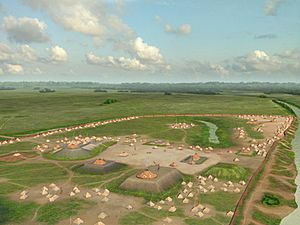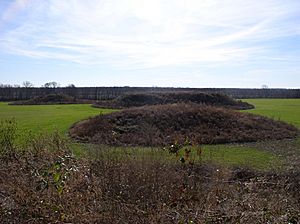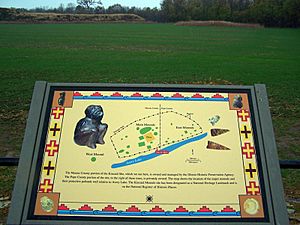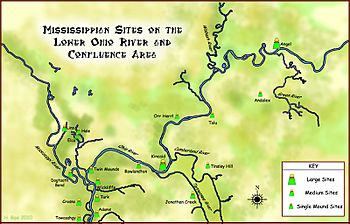Kincaid Mounds State Historic Site facts for kids
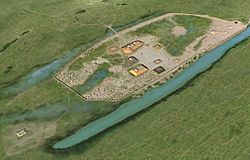
Illustration of the late occupation phase of the site circa 1300 CE
|
|
| Location | Brookport, Illinois, |
|---|---|
| Region | Southern Illinois |
| Coordinates | 37°4′50″N 88°29′30″W / 37.08056°N 88.49167°W |
| History | |
| Cultures | Middle Mississippian culture |
| Site notes | |
| Archaeologists | Fay-Cooper Cole, Richard MacNeish |
| Architecture | |
| Architectural styles | platform mounds |
| Architectural details | Number of monuments: 19 |
|
Kincaid Site
|
|
| NRHP reference No. | 66000326 |
| Significant dates | |
| Added to NRHP | October 15, 1966 |
| Designated NHL | July 19, 1964 |
The Kincaid Mounds Historic Site is an ancient archaeological site located in southern Illinois, right by the Ohio River. It was an important center for the Mississippian culture between about 1050 and 1400 CE. This site is special because it helps us understand the history of Native Americans in North America. It also shows how modern archaeology has grown over time.
The people who lived here built at least 11 large platform mounds. These are huge, flat-topped hills made by people. They also built 8 other structures. Kincaid Mounds is one of the top five Mississippian sites with the most mounds. The objects found here show that the main time of building and living at Kincaid was during the Mississippian period. This site is about 140 miles from Cahokia, which was the biggest Mississippian city. Before the Mississippian people, other groups from the Woodland period also lived at Kincaid. In 1964, Kincaid was named a National Historic Landmark. This was because it was a major Native American mound center and a trading hub along the Ohio River.
Exploring the Kincaid Mounds Site
The Kincaid site is located in a flat area next to the Ohio River. It crosses two counties in southern Illinois: Massac and Pope. This part of Illinois is sometimes called "Little Egypt."
From 1934 to 1941, the University of Chicago led major excavations here. Many future famous anthropologists and archaeologists learned their skills at Kincaid. One of them was Richard MacNeish, who later discovered where maize (corn) first came from. Since 2003, new studies have been done at the site. Teams from Southern Illinois University have used new technology. They have found important new information, including another mound.
The Illinois Historic Preservation Division now owns and manages part of the Kincaid site in Massac County. This area includes several mounds. It covers about 141 acres and was once surrounded by a wooden palisade (a tall fence). There was also a larger area where people lived to the west. The part of the site in Pope County is still privately owned.
When the University of Chicago dug at Kincaid in the 1930s and 1940s, they found nine mounds in Massac County. In 2003, a tenth mound was identified. It was a small mound that was later covered by a trash heap. It is near the current road, close to the county line. The Chicago archaeologists had dug around this mound. But they were not sure if it was a real mound, so they did not include it in their list. Southern Illinois University confirmed it was a human-made earthwork after returning to the site in 2003.
A Look at Kincaid's Past
Archaeologists from the University of Chicago found signs of people living in the Kincaid area for thousands of years. This goes back to the Archaic Period (8000 to 2000 BCE). During this time, people did not use pottery. But their way of life was similar to later groups in the Woodland period, like the Adena culture.
More people lived here during the Early Woodland and Middle Woodland periods. This was similar to the Adena and Hopewell cultures. People started living in one place more often and began to farm. They used pottery made with limestone and built semi-permanent homes. This period is called the Baumer phase. The Baumer people at Kincaid decorated their pottery with cord and fabric marks. They also used more limestone and grog in their clay. In 2003, archaeologists found six pits from the Baumer phase. These pits dated from 250 BCE to 1 CE. One pit held the buried remains of a small dog, which was a rare discovery.
People continued to live at Kincaid during the Late Woodland period. This time is known as the Lewis culture.
The most important time at Kincaid was during the Mississippian culture period. This culture grew from the local Lewis community around 1050 CE. Kincaid was close to Cahokia, only about 140 miles away. Cahokia was the biggest Mississippian site in North America. Kincaid was likely influenced by its development. The Mississippian people at Kincaid built at least 19 earthwork mounds. Most of these were the typical Mississippian platform mounds. Since 2003, Southern Illinois University teams have been studying the site more closely.
The Mississippian people created a large central plaza by filling and leveling the ground. This plaza was in the middle of their community. The main mounds surrounded it. One mound is almost 500 feet long. While none of Kincaid's mounds are as big as Monks Mound at Cahokia, the largest one is still very big. It ranks 12th in size among all known Mississippian mounds. The entire Kincaid site ranks 5th in size among Mississippian sites for the number of mounds built there. The other platform mounds range from 8 feet to 30 feet tall.
Archaeologists found remains of large buildings on top of the main mounds. These buildings might have been temples or meeting houses. Carved figures made from coal and fluorite were also found. These carvings show images connected to the Southeastern Ceremonial Complex (SECC), a shared set of beliefs and symbols. Trade for chert (a type of stone) seemed to reach into Missouri, Tennessee, and other parts of Illinois. Many pieces of Mill Creek chert, which came from nearby quarries, were found at the site. Mississippian culture pottery with special painted designs is also common at Kincaid.
In the 1930s, the Chicago team dug into a major burial mound called Pope Mound 2. This showed that Kincaid had a complex social structure, like a chiefdom. The mound contained several stone box graves and log-lined tombs. These are similar to graves found in Tennessee.
The Mississippian culture stopped living at Kincaid around 1400–1450 CE. There are no records of later Native American tribes living there. The site was probably abandoned because the people had used up the timber and game (animals for hunting) in the area. It remained empty for about 300 years until American settlers arrived.
The Kincaid Focus: A Regional Connection
In the lower Ohio River valley, there are several Mississippian towns. These include Kincaid in Illinois, Wickliffe in Kentucky, Tolu in Kentucky, and Angel Mounds in Indiana. These sites are grouped together as the "Kincaid Focus." This is because their pottery and site layouts are very similar.
The connections between Kincaid and Angel Mounds are especially strong. They have similar site plans, similar styles of artifacts, and are geographically close. Because of these links, some experts believe that the people who built and lived at these sites were part of the same society.
The time period when these types of artifacts and sites are found is called the "Angel Phase." It lasted for 300 to 400 years. This phase is divided into three smaller periods:
| Subphases | Dates |
|---|---|
| Jonathan Creek | 1000–1100/1200 |
| Angelly | 1200–1300 |
| Tinsley Hill | 1300–1450 |
Rare painted and carved pieces of Mississippian pottery have been found at all four sites. At Kincaid, less than one percent of the pottery is painted or carved. At Wickliffe, it's about three or four percent. Some common pottery styles found at these sites include Angel Negative Painted, Kincaid Negative Painted, and Matthews Incised. This pottery was made with shell mixed into the clay. It ranges from rougher pottery with larger shell pieces to smoother, more polished pottery with finer shell pieces.
|



